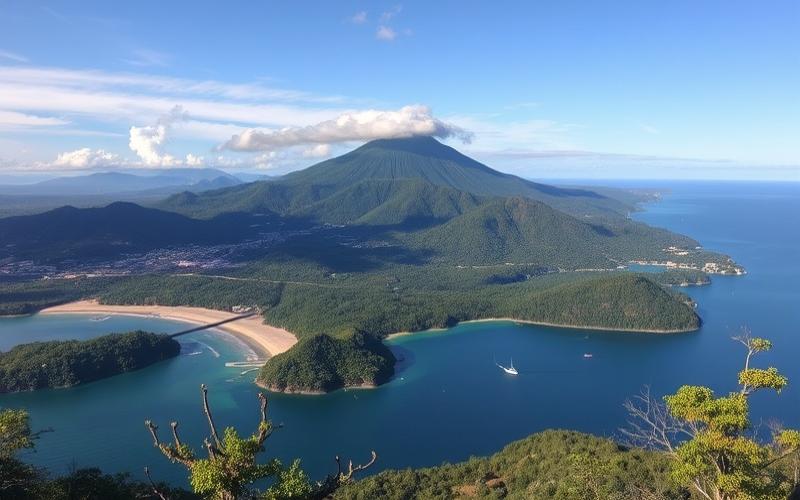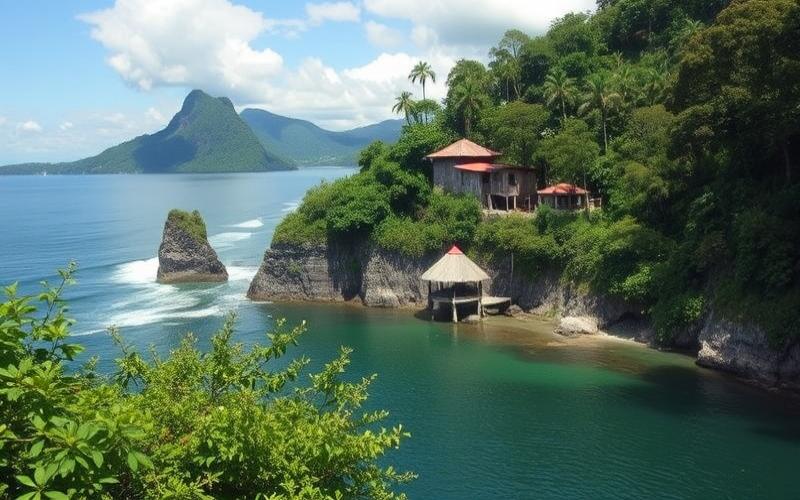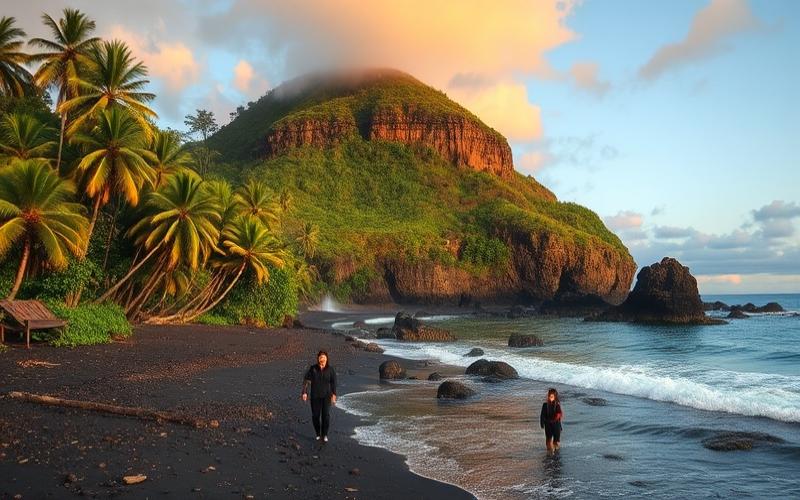
 Published on and written by Cyril Jarnias
Published on and written by Cyril Jarnias
The Rise of Co-living Spaces in Costa Rica
In a country where lush biodiversity blends with an enviable quality of life, Costa Rica is witnessing an emerging trend transforming its real estate market: the rise of co-living spaces. These shared living spaces, increasingly attracting expatriates and locals alike, offer an appealing alternative to traditional housing by emphasizing community, flexibility, and resource sharing.
Thus, in a context where real estate demand is becoming more complex, co-living presents itself as an innovative solution, combining economic efficiency and community spirit, while perfectly aligning with the country’s “pura vida” philosophy.
The Growth of Co-living Spaces Among Costa Rica’s Youth
Young Costa Ricans are increasingly adopting the concept of co-living spaces under the influence of sociocultural, economic, and technological factors. This trend aligns with a context of increased digitalization and the popularization of remote work.
Sociocultural and Economic Factors Driving Co-living Adoption:
- High housing costs in urban and tourist centers, making individual home ownership difficult for many young people.
- Search for community and shared experiences, particularly among students, young professionals, digital nomads, and remote workers.
- Increased professional mobility, facilitated by the digital economy and the flexibility offered by telecommuting.
- Growing individualization, but with a desire to avoid the traditional social isolation of individual housing.
Influence of Digitalization and Remote Work:
- Costa Rica has become a popular destination for digital nomads and remote workers, thanks to improved internet infrastructure and the creation of appropriate visas.
- Co-living spaces offer suitable infrastructure (high-speed Wi-Fi, integrated coworking spaces), meeting the expectations of this new generation of mobile workers.
- Digitalization facilitates the search for co-living through specialized platforms, allowing users to compare and book spaces according to their needs.
Recent Statistics on Co-living Space Growth and Distribution:
| Region | Number of Co-living Spaces (2024) | Notable Examples |
|---|---|---|
| San José (GAM) | 10+ | Unity Coliving, Stolas Coliving |
| Pacific Coast (Santa Teresa, Jaco, Tamarindo, Nosara) | 15+ | Outsite Santa Teresa, Selina Tamarindo |
| Caribbean (Puerto Viejo) | 3+ | Selina Puerto Viejo |
| Rural/Mountain Areas | 2-3 | Selina Monteverde, Selina La Fortuna |
- Since 2022, the number of co-living spaces has increased by over 30%, with strong concentration in the Greater Metropolitan Area (GAM) and tourist coastal areas.
- Major operators like Selina and Outsite have opened several sites tailored to young professionals and digital nomads.
Perceived Benefits for Young People:
- Cost sharing (rent, utilities, internet), enabling access to better located or equipped housing.
- Community building: sense of belonging, event organization, mutual support among residents.
- Networking opportunities for professional and personal growth, fostering skill exchange and collaborative projects.
- Flexibility: short or medium-term rentals suited to mobile lifestyles.
Comparison with Traditional Housing Forms in Costa Rica:
| Criterion | Co-living | Traditional Housing |
|---|---|---|
| Cost | Shared, often more affordable | Higher for individual housing |
| Community | Strong, organized | Weak, potential isolation |
| Flexibility | High (short/medium term) | Low (standard annual leases) |
| Included Services | Yes (Wi-Fi, cleaning, coworking) | Rarely included |
| Professional Opportunities | Numerous (networking) | Limited |
Implications for the Local Real Estate Market:
- Transformation of the rental market: increased demand for flexible, equipped housing at the expense of traditional long-term rentals.
- Revitalization of tourist and urban neighborhoods, with the creation of new community living hubs.
- Price pressure in attractive areas, potentially exacerbating housing accessibility challenges for local populations.
- New investment opportunities for property owners and real estate developers, with diversified offerings.
Co-living thus establishes itself as an innovative response to the needs of young Costa Ricans, aligned with the evolution of the job market and societal transformations driven by digitalization.
Good to Know:
In Costa Rica, the adoption of co-living spaces by young people is driven by economic and sociocultural factors, including digitalization and the rise of remote work, which enable geographic flexibility and cost reduction. Recent statistics indicate a 30% increase in these spaces, primarily around major cities like San José and Liberia, reflecting a growing need for affordable alternatives to traditional housing. Young people appreciate co-living spaces for their shared costs, fostering a sense of community and offering excellent networking opportunities. Compared to traditional housing forms, this flexible model better meets the needs of young professionals seeking collectivism and cost-effectiveness, thereby influencing the real estate market toward more innovative and sustainable solutions.
The Appeal of Upscale Co-living
Upscale co-living spaces in Costa Rica are increasingly attracting professionals, expatriates, and digital nomads through a unique combination of community, economy, and superior comfort.
Main Attractions of Upscale Co-living:
- Reduced cost: Sharing an upscale residence allows access to luxury properties and amenities (pool, gym, coworking spaces) at a much more advantageous rate than individually renting an equivalent property.
- Rich social life: These spaces promote the creation of a dynamic social network, essential for newcomers and travelers looking to build connections in an international and tourist setting.
- Flexibility: Contracts are generally flexible, without long-term commitments, perfectly meeting the mobility needs of digital nomads and traveling professionals.
- Included services: Premium services often include:
- Regular cleaning
- 24/7 security
- High-speed internet
- Quality common areas (equipped kitchen, living room, terraces, gardens)
- Access to community activities and internal events
Comparison: Upscale Co-living vs. Individual Rental:
| Criterion | Upscale Co-living | Traditional Individual Rental |
| Price per person | More advantageous | Often higher |
| Luxury amenities | Included | Rare or costly |
| Services (cleaning, security) | Included | Self-organized |
| Social life | Dynamic, international | Limited |
| Flexibility | Short-term contracts | Often long-term contracts |
Examples of Renowned Co-living Spaces in Costa Rica:
- Selina Costa Rica: Present in several cities (Tamarindo, Santa Teresa, San José), offers private or shared rooms, coworking spaces, social activities, pool, restaurant.
- Outsite Costa Rica: Specialized for digital nomads, offers designer accommodations, international community, collaborative workspaces, and an atmosphere focused on productivity and well-being.
- Drifter Coliving (Santa Teresa): Modern spaces, community focus, regular organization of events to foster integration.
- CoCoVivo (Bocas del Toro, near Costa Rican border): Eco-friendly upscale housing, community experiences, nature immersion.
Additional Services and Benefits:
- Access to gyms, pools, and wellness spaces directly within the residence.
- Regular community activities (yoga, surfing, professional workshops, evening events).
- Professional network and mutual support among residents from various sectors.
- Secure environment, essential in tourist or isolated areas.
This Concept Meets Growing Demand From:
- Professionals on assignment: Seeking temporary housing without long lease constraints.
- Expatriates: Wanting to integrate quickly and benefit from a comfortable setting.
- Digital nomads: Seeking productivity, flexibility, and a community of like-minded peers.
Key Takeaways:
- Upscale co-living in Costa Rica combines luxury, community, and economy.
- It appeals to an international clientele seeking flexibility and enriching social experiences in a secure, equipped environment.
- Included services simplify daily life and allow focus on essentials: work, exploration, and connections.
Upscale co-living in Costa Rica: a lifestyle blending comfort, community, and freedom, ideal for a mobile and connected generation.
Good to Know:
Upscale co-living spaces in Costa Rica offer an economic and social alternative to individual rentals, providing included services such as cleaning and security, and facilitating the creation of an international social network. These spaces attract professionals, expatriates, and digital nomads through their luxury amenities and high-quality common areas. Places like Selina in Manuel Antonio or Outsite in Nosara exemplify this trend, meeting growing demand for flexible and community-oriented environments. In addition to promoting a sophisticated living environment, these spaces encourage a dynamic community life, allowing residents to benefit from often tourist-friendly settings while enjoying the efficiency of modern infrastructure.
Shared spaces refer to living or working environments where multiple people, often unrelated, cohabit by pooling certain services and facilities. They differ from traditional housing through the presence of common areas (living rooms, kitchens, gyms, coworking spaces), promoting exchange and community while offering each individual private space (bedroom or studio). Unlike classic roommate situations that primarily share an apartment among individuals without structured additional services, shared spaces are organized around a genuine community with professional management and an expanded range of amenities.
| Space Type | Private Space | Extended Common Areas | Included Services | Structured Community |
|---|---|---|---|---|
| Traditional Apartment | Yes | No | No | No |
| Classic Roommate Situation | Yes | Limited | Few | Weak |
| Co-living/Shared Space | Yes | Yes | Numerous | Strong |
Typical examples of common areas:
- Large living rooms
- Equipped collective kitchens
- Sports or wellness areas
- Multipurpose rooms (cinema/library)
- Outdoor areas/vegetable gardens
In Costa Rica, this trend has seen marked growth since the early 2020s. Several factors explain this development:
Economic Factors
- Rising housing costs in urban centers
- Search for affordable solutions for students/professionals/digital migrants
- Land optimization through sharing
Cultural Factors
- Strong community values within Costa Rican society
- Growing appeal for alternative lifestyles focused on ecology and sharing
Social Factors
- Social isolation exacerbated by rapid urbanization
- Mass arrival of expatriates/digital nomads attracted by climate and political stability
- Increased search for belonging through intentional communities
The rise of shared spaces has a noticeable impact on the local real estate market:
- Increase in projects dedicated to co-living/coworking in major cities (San José, Tamarindo…)
- Transformation/renovation of older buildings into modern multifunctional residences
- New appeal for local/international investors attracted by a flexible rental model with high occupancy rates
Many entrepreneurs are now developing their businesses around these concepts; they create not only housing but also hybrid spaces blending long-term temporary accommodation and event activities.
Testimonials collected from Costa Rican residents:
“Living here not only allows me to reduce my expenses but especially to meet someone from around the world every week. We share more than just a roof: we build our daily life together.” — Laura M., resident in San José
“I chose this shared space because I work remotely: having direct access to an equipped coworking space in my building is ideal. But what really makes the difference is the warm atmosphere you find as soon as you step into the common kitchen!” — Pablo R., digital nomad settled in Tamarindo
Environmental benefits are notable:
- Sharing significantly reduces individual carbon footprint.
- More rational use of resources (water/energy).
- Active promotion of collective composting or urban gardening.
On a social level, these habitats promote:
- Intergenerational/multicultural inclusion.
- Solidarity development through daily mutual aid.
- Combating growing urban isolation.
Integrated into global movements for a sustainable and collaborative society, shared spaces perfectly embody this transition toward more applied ecology, circular economy, and genuine community. This model thus fully aligns with current trends seeking relational quality as much as material efficiency.
Shared spaces: living better together – economically viable,
ecologically responsible,
humanly enriching
Good to Know:
In Costa Rica, shared spaces, or “co-living spaces,” distinguish themselves from traditional housing through their community approach, fostering collaboration and resource sharing among residents. This trend, booming due to a confluence of economic factors such as real estate market pressure and rising living costs, also fits within a social and cultural context that values collective experiences. Young professionals and digital travelers, often drawn to an eco-friendly and flexible lifestyle, testify to the enriching aspect of community living, while enjoying sustainably designed common areas. Locally, these projects create new investment opportunities and revitalize the real estate market while promoting values of sustainability and cooperation, aligned with global movements favoring more ecological and social living.
The Impact of the Digital Community on Lifestyles
Digital platforms play a central role in promoting and managing co-living spaces in Costa Rica, particularly through the use of social media to attract new residents. Co-living managers use Instagram, Facebook, and specialized platforms to share photos, testimonials, and events, creating an attractive showcase for digital nomads, young professionals, and students seeking a community-oriented and flexible lifestyle. Websites like Coliving.com facilitate the search for housing tailored to individual preferences, offering customized options and a secure selection process based on lifestyle criteria.
Examples of Co-living Spaces in Costa Rica Where Digital is Central:
| Space | Location | Digital Usage in Community and Management |
|---|---|---|
| Locoworking | Sámara | Online platforms for organizing workshops, coworking sessions, and social events, private forums for resident exchanges. |
| Coworksurf | Playa Hermosa, Santa Teresa, Avellanas | WhatsApp groups and social networks to coordinate surfing, yoga, and evening activities, instant messaging for daily management. |
The integration of the digital community helps strengthen the sense of belonging and solidarity among inhabitants. Digital tools (private groups, chats, newsletters) facilitate information exchange, organization of collaborative activities, and quick resolution of daily problems. This fosters connection building, mutual aid, and cultural diversity within co-living spaces.
List of Opportunities Linked to Digital Tool Integration:
- Facilitation of instant communication and management of resident requests.
- Automation of administrative processes (bookings, payments, maintenance).
- Access to an expanded community, enabling international networking.
- Organization of virtual or hybrid events (webinars, workshops, sports activities).
List of Challenges to Address:
- Managing information overload and respecting privacy.
- Risk of excessive dependence on digital tools, to the detriment of physical interactions.
- Heterogeneity of digital skill levels among residents.
- Securing personal data and managing online conflicts.
The digital community profoundly influences resident preferences toward more flexible and collaborative lifestyles. Online interactions encourage mobility, openness to diversity, and experimentation with new cohabitation models. Residents are often motivated by the possibility of sharing experiences, learning new skills, and participating in collective projects, while maintaining individual autonomy.
The impact of the digital community translates into a lasting transformation of lifestyles, where flexibility, collaboration, and a sense of belonging take precedence over traditional residential models.
Good to Know:
Digital platforms play a crucial role in promoting and managing co-living spaces in Costa Rica, with social media being particularly effective in attracting new residents by highlighting the community lifestyle. For example, spaces such as Selina and Impact Hub use online interactions to plan events and strengthen the sense of solidarity among inhabitants. Digital tools offer opportunities to integrate modern management systems facilitating bookings and communication, although this sometimes poses challenges in terms of privacy and data management. The digital community also fosters preferences for flexible and collaborative lifestyles, influencing a growing trend toward shared living structures adapted to digital nomads.
Disclaimer: The information provided on this website is for informational purposes only and does not constitute financial, legal, or professional advice. We encourage you to consult qualified experts before making any investment, real estate, or expatriation decisions. Although we strive to maintain up-to-date and accurate information, we do not guarantee the completeness, accuracy, or timeliness of the proposed content. As investment and expatriation involve risks, we disclaim any liability for potential losses or damages arising from the use of this site. Your use of this site confirms your acceptance of these terms and your understanding of the associated risks.















































